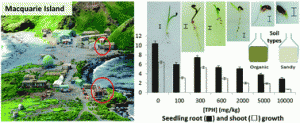These days it seems human activity knows no bounds, reaching as far as the polar regions which have seen an increased flurry of anthropogenic disturbance due to research and tourism. As a result of these activities, fuel spills and their detrimental effects on the local ecosystem are not uncommon in the sub-Antarctic and Antarctic.
It has been estimated that soil in the Antarctic covering an area the size of (10 million cubic meters) is contaminated with hydrocarbons. This environment presents barriers to natural removal of hydrocarbons including low nutrient content and low temperatures that limit microbial activity, as well as low rates of volatilization and evaporation caused by the same reason. Establishing reasonable remediation targets requires a thorough understanding of the biological effects of petroleum hydrocarbons, which can be achieved using biological assays. Though international protocols for such assays have been modified for application to Arctic and cold-climate species, our knowledge of the effects of hydrocarbons on plants in these regions is still lacking.
A recent study by Macoustra and co-workers is one of the few to provide such data for the sub-Antarctic region. The researchers first collected seeds from 12 native plants on Macquarie Island, the site of one of Australia’s scientific research stations and multiple diesel fuel spills. They tested the seeds for their suitability for bioassays in the lab, and used the species that successfully germinated in a second bioassay involving exposure to a range of diesel concentrations in soils, at both high and low organic carbon contents. Only four species were able to germinate during the second bioassay, indicating that diesel-contaminated soils reduced germination success.
Using the four species that germinated during the second bioassay, a final bioassay was performed over a 28 day period, again with soils exhibiting a range of diesel contamination and either low or high organic carbon content. The endpoints assessed were germination success, and early-life root and shoot growth. The researchers found that soils with low organic carbon content were generally more toxic to plants than high organic carbon content, and attribute this to the lower bioavailability of organic contaminants associated with higher levels of organic matter, in addition to higher nutrient levels that promote plant growth and higher rates of microbial degradation of petroleum hydrocarbons. Root growth was the most sensitive endpoint, likely due to the high permeability of early-life root tissues.
Though the concentrations of petroleum hydrocarbons necessary to inhibit early growth were similar to those likely to be found very close to a spill site, the unique conditions in the sub-Antarctic that greatly inhibit hydrocarbon loss processes mean that such concentrations can persist in the environment.
Prior to this study by Macoustra and co-workers, there was no such toxicity data for early life stages of native sub-Antarctic plants exposed to petroleum hydrocarbons. This data is extremely useful for models currently being developed to assist in creating remediation targets for the sub-Antarctic, as the models require a certain number of species from a minimum number of taxonomic groups.
To read more about this research, download a copy of the manuscript for free* by clicking the link below.
Impact of hydrocarbons from a diesel fuel on the germination and early growth of subantarctic plants
GK Macoustra, CK King, J Wasley, SA Robinson and DF Jolley
Environ. Sci.: Processes Impacts, 2015, Advance Article
DOI: 10.1039/C4EM00680A
—————-

About the webwriter
Abha Parajulee is a Ph.D. student at the University of Toronto Scarborough. She is interested in water resources and the behavior of organic contaminants in urban environments.
—————-
* Access is free until 06/09/2015 through a registered RSC account.











